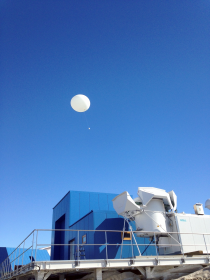Scientific Research on Antarctica
Vaisala working together with our partners, installed an AUTOSONDE at Korean Antarctic Jang Bogo station, Terra Nova Bay, Antarctica. Korea Polar Research Institute (KOPRI), the operator of Jang Bogo station, use the AUTOSONDE to measure prevailing conditions in this remote and challenging environment.
The scale and scope of Vaisala's capabilities are often highlighted. And these proven capabilities are based on facts. From harsh Arctic environments to tropical regions, even in outer space, Vaisala products can be found collecting and analyzing valuable data for our customers. These harsh environments put Vaisala's products to the ultimate test, every day. The Autosonde installed in Antarctica is no exception.
Year-Round Research
Kalle Rieppola, Vaisala Field Service Engineer, who completed the installation, got to experience the constraints of working at one of the most remote locations in the world, first hand. Some 1,000 to 5,000 people are living at various research stations on Antarctica throughout the year. The AUTOSONDE
installation took place during the Antarctic summer, when the conditions are mild enough to support key activities in preparation for the coming year. The summer period allows organizations and research institutes the opportunity to stock up on supplies. Also, new teams arrive to replace people that have been on the continent for the previous year. During his time with scientists, engineers and researches on the KOPRI base, Kalle highlighted that the vast open space can be misleading. "For example, when you see a mountain in the distance, it looks to be just a few kilometers away. And then you learn it is actually over 30 kilometers away." Kalle says that during his brief time on the continent, the schedule to complete the installation was tight. He states that it was truly an unforgettable trip and with a smile notes that eventually the AUTOSONDE will need to be updated to use the new Vaisala Radiosonde RS41.
Chanseok Park, Vaisala Sales Manager for Korea states, "KOPRI is conducting regular soundings from mid-February to late October. They also conduct ozone soundings once a week around the period of 'ozone hole occurrence' from mid-August to mid-October. The KOPRI staff in Antarctica is very satisfied with the performance of the AUTOSONDE in such a demanding environment." In collaboration with the Korea Meteorological Administration (KMA), a researcher has been dispatched from KMA headquarters to Jang Bogo station to operate the AUTOSONDE and analyze sounding data. After the internal data evaluation was completed, the AUTOSONDE started to share its data to the World Meteorological Organization's Global Telecommunication System. In addition to the AUTOSONDE, a complete Vaisala Automatic Weather Station system and optical sensors such as ceilometer and present weather sensor are supporting the operational research activity.
According to KOPRI, "We were looking for truly reliable automated sounding system which can operate in extremely demanding condition and there's no doubt that we have made the right choice." Korea is the 10th country which has more than two research bases in Antarctica."

